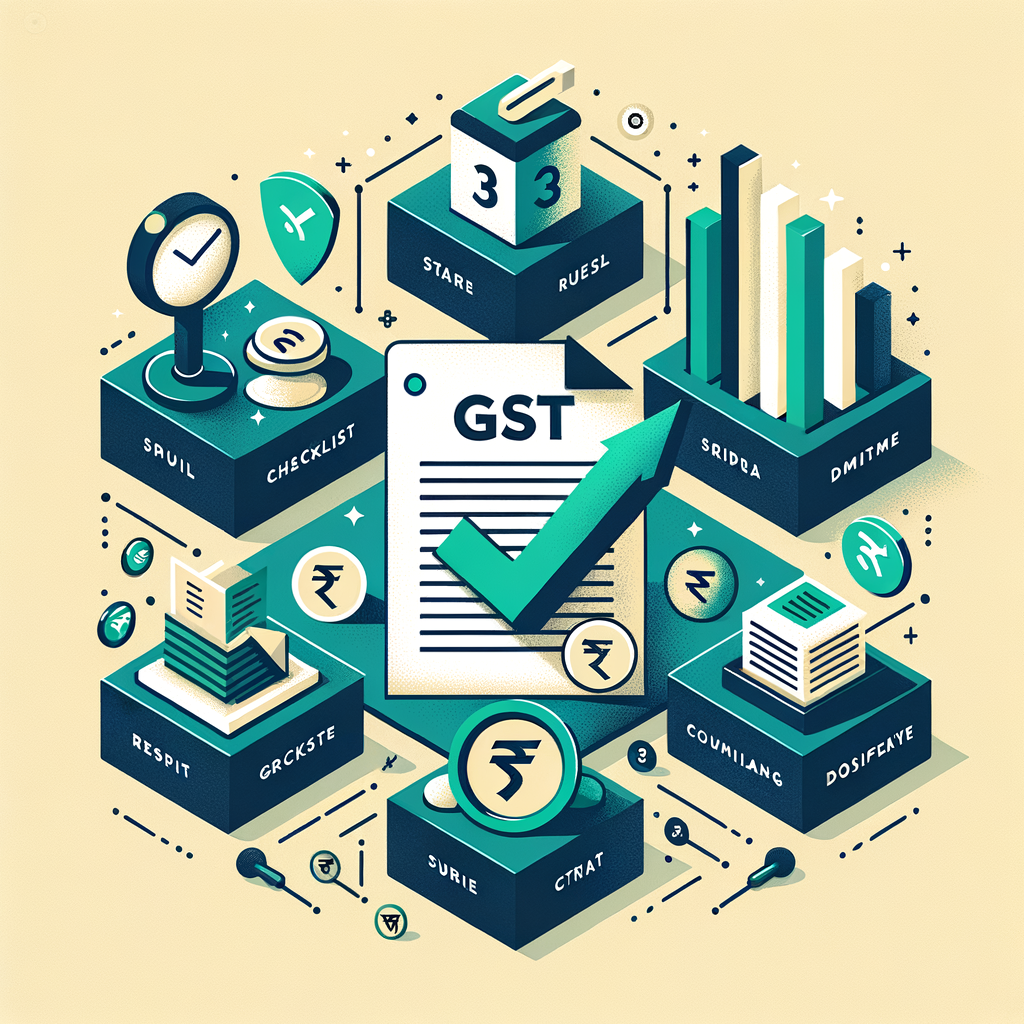GST for Startups and Small Businesses – Compliance Simplified
For entrepreneurs in India, every day is a balancing act. Juggling operations, chasing sales targets, managing teams, and keeping a close eye on finances is a monumental task. Amidst this hustle, navigating complex regulations can feel overwhelming, and the Goods and Services Tax (GST) often seems like a formidable challenge for new ventures. This is where a clear understanding becomes crucial. This blog post is designed to be your simple, actionable small business GST compliance guide, breaking down the complexities into manageable steps. We aim to demystify the rules and provide a clear roadmap to ensure your business masters GST compliance for small businesses and meets the necessary compliance for startups India from day one, setting a strong foundation for future growth.
What is GST and Why is it Crucial for Your Business?
At its core, the Goods and Services Tax (GST) is a comprehensive, destination-based indirect tax that has replaced numerous other indirect taxes in India, such as VAT, Service Tax, and Excise Duty. Think of it as a single, unified tax applied on the supply of goods and services, from the manufacturer to the final consumer. For a startup or small business, being GST compliant is not just a legal obligation; it’s a strategic business advantage. Proper compliance allows you to claim Input Tax Credit (ITC), which means you can reduce your tax liability by claiming credit for the GST paid on your business purchases and expenses. Furthermore, a good GST compliance rating, visible on the public GST portal, enhances your credibility with potential clients, vendors, and financial institutions. It also facilitates seamless inter-state trade without the hassle of multiple state-level taxes, opening up a larger market for your products or services and creating a more transparent and organized business ecosystem.
Understanding the GST Components: CGST, SGST, and IGST
To navigate GST effectively, you must first understand its three main components, which depend on whether a transaction is within a state (intra-state) or between states (inter-state). This structure ensures that tax revenue is correctly apportioned between the Central and State governments.
- CGST (Central GST): This is the tax collected by the Central Government on an intra-state sale. For instance, if a business in Mumbai, Maharashtra sells goods to a customer also in Mumbai, the GST collected will be split into two parts: CGST and SGST.
- SGST (State GST): This is the tax collected by the State Government on that same intra-state sale. So, on that Mumbai-to-Mumbai transaction, the state of Maharashtra collects the SGST portion of the total tax.
- IGST (Integrated GST): This is the tax collected by the Central Government for all inter-state sales. If that same business in Mumbai, Maharashtra sells goods to a customer in Bengaluru, Karnataka, only IGST is levied. This single tax simplifies the process for cross-border transactions, and the Central Government later apportions the collected IGST to the destination state (Karnataka, in this example).
GST Registration Thresholds: Does Your Business Need to Register?
One of the first questions for any new entrepreneur is whether they need to register for GST at all. The government has set specific turnover thresholds to keep very small businesses out of the GST net, simplifying their operations. Understanding these limits is the first step in your compliance journey.
The current annual aggregate turnover thresholds for GST registration for new businesses are:
- ₹40 Lakhs for businesses exclusively supplying goods.
- ₹20 Lakhs for businesses exclusively supplying services (or a mix of goods and services).
- Special Category States: For certain states in the North-East and hilly regions, these thresholds are lower (typically ₹20 Lakhs for goods and ₹10 Lakhs for services).
However, some businesses must register for GST irrespective of their turnover. Mandatory registration is required if your business:
- Makes any inter-state taxable supply of goods.
- Is an e-commerce aggregator or sells goods through an e-commerce platform (like Amazon or Flipkart).
- Is a Casual Taxable Person or a Non-Resident Taxable Person.
- Is required to pay tax under the Reverse Charge Mechanism (RCM).
A Step-by-Step Guide to GST Registration for New Businesses
Once you’ve determined that your business needs to register for GST, the next step is to complete the application process. Fortunately, the entire process is online and can be completed with the right documents in hand. Being prepared with the necessary paperwork is one of the most critical startups compliance requirements India, as it ensures a smooth and quick registration without unnecessary delays from the tax department. For a detailed walkthrough, you can also refer to our Ultimate Guide to GST Registration for Small Businesses. A systematic approach will help you navigate this crucial step efficiently.
Essential Documents for GST Registration
Before you begin the online application, gather the following documents. Having digital copies ready will significantly speed up the process.
- PAN Card: The Permanent Account Number (PAN) of the business or the individual proprietor.
- Aadhaar Card: Of the proprietor, partners, or directors.
- Proof of Business Registration: This could be the Certificate of Incorporation for a company, the Partnership Deed for a partnership firm, or other relevant registration certificates.
- Business Address Proof: Documents like a recent electricity bill, property tax receipt, municipal khata copy, or a valid rent agreement with an NOC from the property owner.
- Bank Account Details: A scanned copy of a cancelled cheque, bank statement, or the first page of your passbook showing the business name, account number, and IFSC code.
- Photographs: Passport-size photographs of the proprietor, partners, or directors.
- Authorization Proof: For companies and LLPs, a board resolution or authorization letter appointing an authorized signatory is required.
The Online Registration Process: A Quick Walkthrough
The registration process is handled through the official government portal. Follow these steps carefully to submit your application correctly.
- Visit the Official GST Portal: Go to the government’s official website at https://www.gst.gov.in/.
- Generate a TRN: Under the ‘Services’ tab, navigate to ‘Registration’ and click on ‘New Registration’. Fill in your basic details like PAN, mobile number, and email address. You will receive an OTP on both your mobile and email to validate them, after which a Temporary Reference Number (TRN) will be generated.
- Fill out Part-B: Use the TRN to log in and proceed to fill out Part-B of the application form. This is where you will provide detailed information about your business, promoters/partners, authorized signatory, principal place of business, and bank accounts.
- Upload Documents: In the relevant sections, upload the scanned copies of all the documents you gathered earlier.
- Submit the Application: Verify all the details and submit the application using either a Digital Signature Certificate (DSC) for companies/LLPs or an Electronic Verification Code (EVC) sent to your Aadhaar-linked mobile number.
- Receive ARN and Await Approval: Upon successful submission, an Application Reference Number (ARN) is generated. You can use this ARN to track the status of your application. A tax officer will review your application and documents. If everything is in order, your GST Identification Number (GSTIN) will be issued within 3-7 working days.
Mastering Ongoing GST Compliance for Small Businesses
Obtaining your GSTIN is just the beginning of your journey. The real challenge, and the most critical aspect of GST compliance for small businesses, lies in managing the ongoing requirements. This includes issuing proper invoices, filing timely returns, and accurately managing your tax credits. Establishing a robust system for these activities from the very start is essential to avoid penalties, maintain a healthy cash flow, and build a reputation as a reliable and compliant startup in India. Neglecting these responsibilities can lead to significant financial and legal complications down the line.
Correct Invoicing: The First Step to Compliance
Your invoice is the primary document in the GST ecosystem. It’s not just a bill for your customer; it’s a legal document that forms the basis for their Input Tax Credit and your tax liability. A GST-compliant tax invoice must contain specific mandatory fields to be considered valid. For more details, see our Understanding GST Invoicing: A Detailed Guide.
Ensure every invoice you issue includes:
- Supplier’s name, address, and GSTIN.
- Recipient’s name, address, and GSTIN (if registered).
- A unique, consecutive serial number (invoice number).
- Date of issue.
- HSN Code for goods or SAC Code for services.
- Description and quantity of goods or services.
- Total value of the supply.
- Taxable value after deducting any discounts.
- Applicable tax rates (CGST, SGST, IGST shown separately).
- Amount of tax charged.
- Place of supply.
- Signature or digital signature of the supplier.
The GST Filing Process for Startups: Key Returns to Know
Filing returns is a non-negotiable part of GST compliance. It is the process through which you report your sales and purchases to the government and pay your tax liability. You can find a detailed walkthrough in our guide on How to File GST Returns Online: A Step-by-Step Guide of the GST Filing Process & Procedure. Understanding the primary returns is fundamental to the GST filing process for startups.
- GSTR-1: This is the return for your outward supplies (sales). You must provide invoice-wise details of all sales made during the tax period. For most businesses, the due date is the 11th of the following month.
- GSTR-3B: This is a summary return. Based on your sales (from GSTR-1) and eligible Input Tax Credit, you calculate your net tax liability and pay it while filing GSTR-3B. The due date is typically the 20th of the following month for most taxpayers.
- QRMP Scheme: To simplify compliance for startups and small businesses with an annual turnover of up to ₹5 crores, the government introduced the Quarterly Return Monthly Payment (QRMP) scheme. Under this scheme, you can file your GSTR-1 and GSTR-3B on a quarterly basis, while still paying your tax liability monthly through a simple challan.
Understanding Input Tax Credit (ITC)
Input Tax Credit (ITC) is the backbone of the GST regime and a significant benefit for businesses. In simple terms, it allows you to subtract the GST you paid on your business purchases (inputs) from the GST you are liable to pay on your sales (outputs). For example, if you paid ₹1,000 in GST on raw materials and collected ₹2,500 in GST from your sales, you only need to pay the government the difference of ₹1,500.
However, to claim ITC, you must meet the following conditions:
- You must be in possession of a valid tax invoice or debit note issued by your supplier.
- You must have actually received the goods or services.
- The tax charged on your purchases must have been paid to the government by your supplier (you can check this on the GST portal).
- You must have filed your GST return (GSTR-3B).
Actionable GST Compliance Tips for Small Businesses
Staying on top of GST requires discipline and a systematic approach. By implementing a few best practices, you can streamline your processes, reduce the risk of errors, and make compliance a manageable part of your business operations. These practical GST compliance tips for small businesses can save you time, money, and stress in the long run.
Maintain Meticulous Records
The foundation of good GST compliance is immaculate record-keeping. You must maintain organized records of all sales invoices, purchase bills, debit notes, credit notes, payment vouchers, and expense receipts. Digital record-keeping is highly recommended. Create a clear folder structure on your computer or cloud storage and save scanned copies of all documents. This not only makes it easier to file accurate returns but also ensures you are prepared in case of a departmental audit or scrutiny. Your records should be maintained for at least six years as required by GST law.
Use Accounting and Billing Software
Manually creating invoices and tracking tax liabilities can be time-consuming and prone to human error, especially as your business grows. Investing in a good accounting and billing software can be a game-changer. These tools can automate the creation of GST-compliant invoices, track your ITC eligibility, categorize expenses, and generate data for your GSTR-1 and GSTR-3B filings with just a few clicks. This technology is one of the most effective ways to simplify compliance for startups, freeing up your valuable time to focus on core business activities instead of manual data entry and calculations.
Stay Updated on GST Council Meetings and Amendments
GST law is dynamic and subject to frequent changes. The GST Council meets periodically to revise tax rates, introduce new rules, and clarify procedures. A change in the tax rate for your product or a new compliance requirement can directly impact your business. It is crucial to stay informed about these updates. You can follow official government sources like the CBIC website or trust reliable professional partners, such as the TaxRobo blog, to provide you with timely and easy-to-understand summaries of important GST amendments.
Consider Professional Guidance
While managing GST in the early days might seem doable, tax laws can become increasingly complex as your business scales, diversifies, or expands across states. Instead of spending countless hours trying to decipher intricate tax rules, consider seeking professional help. A tax expert can ensure your returns are filed accurately and on time, optimize your ITC claims, and provide strategic advice on tax planning. Partnering with a firm like TaxRobo ensures you remain a compliant startup in India, minimizing your risk of penalties and allowing you to focus with confidence on what you do best—innovating and growing your business.
Conclusion
Navigating the world of GST can seem complex at first, but it is an essential part of running a successful business in India. By breaking it down into key steps—understanding the basics, registering on time, maintaining proper invoices and records, and filing accurate returns—you can build a strong and compliant foundation. Mastering GST compliance for small businesses is not merely about ticking a regulatory box or avoiding penalties; it is about establishing credibility, improving cash flow through ITC, and creating a sustainable business poised for long-term growth.
Feeling overwhelmed with GST compliance? Let TaxRobo help. Our team of experts can handle everything from registration to monthly filings, so you can focus on what you do best—growing your business. Contact Us Today for a Free Consultation!
Frequently Asked Questions (FAQs)
1. What is the penalty for not filing GST returns on time?
If you fail to file GST returns by the due date, you will be liable for a late fee. The late fee is ₹50 per day of delay (₹25 for CGST and ₹25 for SGST) for each return. For nil returns (where there is no tax liability), the fee is reduced to ₹20 per day (₹10 CGST and ₹10 SGST). Additionally, if you have a tax liability, you will be charged interest at 18% per annum on the outstanding tax amount for the period of delay.
2. Can I opt for the GST Composition Scheme as a small business?
Yes, the Composition Scheme is designed for small taxpayers to ease their compliance burden. You can find more details in our guide on Understanding the Composition Scheme Under GST. If your annual turnover is up to ₹1.5 crore (or ₹75 lakh for certain states), you can opt for this scheme. The key benefits are a flat, lower tax rate (typically 1% for traders and manufacturers) and the need to file only one quarterly statement instead of monthly returns. However, the major drawbacks are that you cannot collect tax from your customers on your invoices, and you are not eligible to claim Input Tax Credit (ITC) on your purchases.
3. Is GST registration mandatory if my turnover is below the threshold?
No, if your aggregate annual turnover is below the prescribed threshold (₹40 lakh for goods, ₹20 lakh for services), GST registration is not mandatory. However, this exemption does not apply if you are involved in specific activities like inter-state supply of goods, selling through an e-commerce platform, or are liable under the reverse charge mechanism. Many businesses also choose to register voluntarily even if their turnover is low, as it allows them to claim ITC on their purchases and makes them more attractive to larger, GST-registered business clients.
4. How often do I need to file GST returns?
For most regular taxpayers, the primary returns, GSTR-1 and GSTR-3B, need to be filed on a monthly basis. However, small businesses with an aggregate annual turnover of up to ₹5 crore have the option to join the QRMP (Quarterly Return Monthly Payment) scheme. Under this scheme, they can file their GSTR-1 and GSTR-3B returns once every quarter, though they are still required to pay their net tax liability every month.



